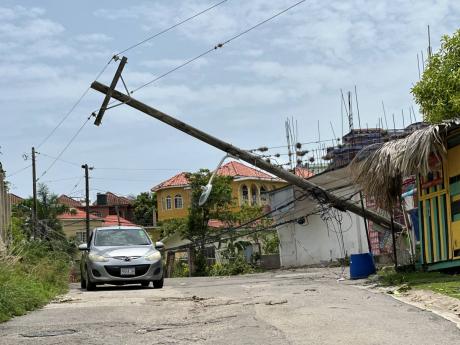Editorial | Case for underground power lines
Jamaica may have escaped the worst of Hurricane Beryl, which passed just south of the island on Wednesday. But that doesn’t mean that it dodged the bullet entirely.
Indeed, the authorities are still totting up the cost of the damage to public infrastructure, such as roads, bridges and electricity and water supply systems, as well as to private property, where the worst hits appear to have been in the south-central and southwestern regions.
However, there was one consequence of the storm that had national reverberations, which should be placed on the national agenda. It is the question of how to harden this element of the island’s infrastructure: the generation and distribution of electricity during natural disasters.
On Wednesday, as Beryl headed west off Jamaica’s south coast with hurricane-force winds sideswiping the island, the Jamaica Public Service Company (JPS), the monopoly transmitter and distributor of light and power, disclosed that around 65 per cent of its customers were without electricity. That amounts to over 440,000 accounts – a figure roughly equivalent to its entire residential customer base, although the outages spread across all categories of electricity users.
Well into Thursday, many communities were still without power.
JPS hasn’t given a full breakdown for this massive loss of electricity. It is, however, safe to assume that, in some instances, the company shut down distribution to protect its systems because of perceived vulnerabilities and other potential dangers. In other cases, high winds and falling trees might have brought down transmission and distribution lines.
CAN BE AVOIDED
Much of these types of outages, this newspaper believes, can be avoided, if, as we have consistently advocated, transmission lines, where possible, but certainly distribution lines, are run underground. Indeed, that used to be the case in the old upper-middle class Kingston suburban community of Hope Pastures, whose power distribution arrangement was established in a special law when the Hope Pastures scheme was being developed in the first years of the 1960s.
The area’s residents want it to be so again, continuing a long fight in the courts to have JPS return to the old arrangement, without homeowners having to pay for it, as the Supreme Court ruled in 2022 (for a second time) that they should. The court upheld JPS’ argument that the Hope Pastures system had grown inefficient and dangerous, not for a lack of maintenance, but because of its obsolescence. The light and power company’s position is that given that its licence is to deliver electricity via overhead lines, if Hope Pastures residents want something otherwise, they have to pay for it. This matter is still being played out in the courts.
Part of this dispute is about aesthetics. Overhead electricity cables that snake from pole to pole and to people’s homes are ugly, a feature that Hope Pastures avoided for half a century. But there are also obvious advantages in having utility lines running underground. They are, for instance, less susceptible to damage and collapse during storms, or being knocked down if, say, a motor vehicle crashes into a utility pole.
Indeed, it used to be the case that Hope Pastures suffered fewer power outages than most communities during natural disasters, and were among the first to return to the grid, once the crisis passed.
This was part of that backdrop against which the then prime minister, Edward Seaga, in the aftermath of Hurricane Gilbert in 1988, floated the idea of Jamaica taking all of its utility cables underground. That starkness of the Gilbert experience punctuated the clear logic of that suggestion: 80 per cent of Jamaica’s houses lost their roofs, and the hurricane cost Jamaica 90 per cent of its GDP. A significant portion of the island was without electricity for months while line crews from Florida helped with the restoration efforts.
LITTLE EFFORT
While Jamaica has trenched fibre-optic trunk cables, there has been little effort to, and even less public discussion of, pursuing Mr Seaga’s proposal of routing utility wires underground; not even after Hurricane Ivan two decades ago cost left the light and power company with over J$1 billion (2004 dollars) in damage to its systems, mostly its transmission and distribution infrastructure. It took several months to rebuild.
We appreciate that taking utility cables underground wouldn’t be an inexpensive exercise, and couldn’t all be completed in the near term. Indeed, when Hope Pastures was built, some costs tripled because of the underground electricity system.
In this regard, as we suggested previously, the transition to underground utility lines would be a phased, long-term project, lasting over 25 to 30 years. If it had started when Seaga first raised the idea, the project would have been completed by now.
At least, Jamaica should begin a serious discussion on the issue now, in the context of Parliament’s ongoing review of the Electricity Act and the pending renewal of some of JPS’ operating licences. These discussions would include who, and how, the project is paid for. The review would also take into account whether it is one of those matters which, from a public policy standpoint, taxpayers would have to contribute, and how the private investors would be allowed to recoup their capital.

